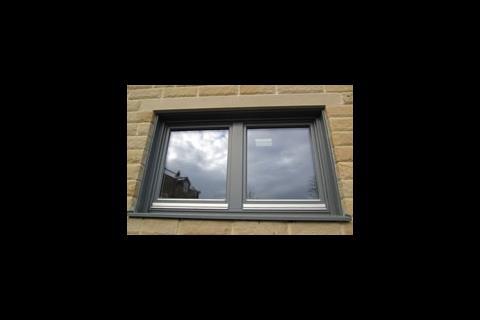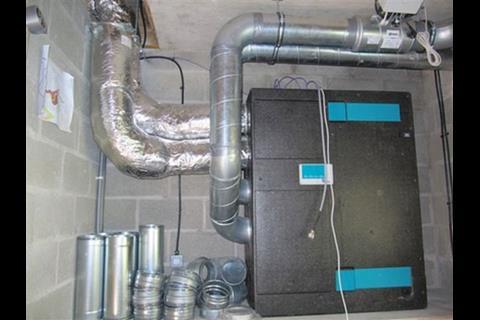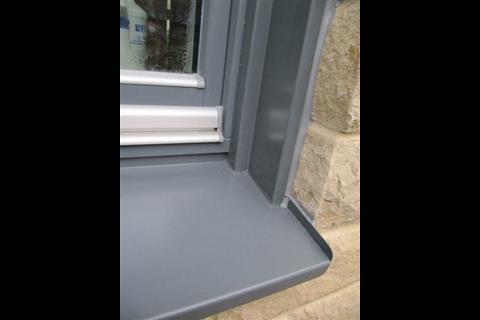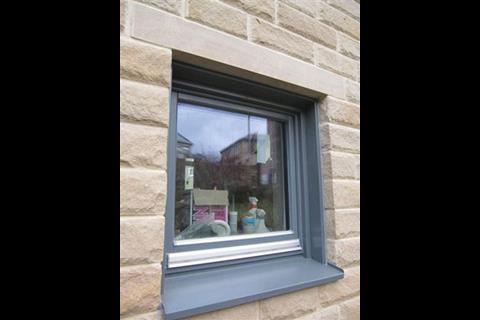As the Denby Dale house completes Bill Butcher reflects on what he’s learned in his penultimate diary entry
We are in the final phase of the Denby Dale build and currently finishing off the bathrooms, kitchen, internal doors and so on. Meanwhile, the Passivhaus certification process is well under way, with the Warm Associates certification team. As this will be the last blog before we announce certification, I wanted to take stock as to how the project has gone and also to reflect on the growing Passivhaus movement in the UK.
Having gone through the Denby Dale process, I feel, more than ever, that Passivhaus is the way forward for the UK. It can help create quality, comfortable buildings while also achieving 90% cuts in occupants’ fuel bills. It offers the UK an easy win solution towards the massive cuts in CO2 emissions we need to make - urgently.
Even if the threat of climate change turns out to be exaggerated – which I don’t believe for a minute – it would still be valuable to build to Passivhaus standards and get energy use down for so many reasons: not least the risk of relying on more and more imported energy, the threat of peak oil and the real problem of fuel poverty.
Easy (relatively!)
What surprised me most when I think of our experience at Denby Dale was how relatively easy it has been to meet the Passivhaus requirements. We overshot the airtightness requirement (0.6 air changes /hour @50Pa) by about 33% (see Week 18: First airtightness test). It looks like we will also come in well under the space heating requirement of 15 kWh/m²/annum.
There were a few last minute adjustments with glazing choices to improve performance and extra insulation wrapping on the window frames, which has helped space heating performance. Conversely, the need to extend the distance between the mechanical ventilation with heat recovery unit in the garage and the house to accommodate ducting fire dampers has reduced performance a bit. At the moment it looks like the space heating needs of the Denby Dale Passivhaus will be in the region of 10-12 kWh/m²/ annum. Certification figures will be released in the final blog.
By deciding to use cavity wall construction in our Passivhaus, we did make things harder for ourselves
By deciding to use cavity wall construction in our Passivhaus, we did make things harder for ourselves. We were trying something new – cavity wall construction hasn’t been applied to Passivhaus construction – and relies on wet plastering as the airtightness barrier. It might have been more straightforward to go down the timber frame route. By using cavity wall we needed to work out new detailing particularly around the junctions of elements such as floors and roof to walls. There was a certain amount of anxiety all the way through the build for me because of this. When I say it was easy to meet the Passivhaus requirements, it is in the context of that anxiety.
Budget
From the build side of things, it has been surprising how smoothly it has all kept to budget. However, there were a lot of provisional sums in the original quote for the finishings, kitchen, flooring and so forth – all the stuff that isn’t to do with being a Passivhaus. The build is going to cost more than the original plan because of personal choices of the customer. The costings for the actual fabric (and the Passivhaus elements) have all stayed within budget.
As this was our first Passivhaus, an awful lot of work went into pre-build research to get it off the ground. The detailing was crucial as we knew right from the beginning that it was going to succeed or fail on the junctions. We had to imagine how the junctions were going to work – how, for example, the floors were going to meet a wall, how we were going to improve on our previous low energy project, the Longwood House, how we were going to get continuity of super insulation and minimise thermal bridging. A lot of time was spent seeing how the windows were going to fit into a cavity wall. I’m really pleased with the outcome. Our solution – using plywood boxes and aluminium cavity closers – offer a robust and unique solution and makes cavity wall a viable way of getting to this sort of performance.
The costs for the research stage were considerable and have been mostly absorbed by Green Building Store. It has been, in effect, a learning process for us and a training and development cost for the business. This has, however, had positive knock-on effect on us as a company. While we’ve been researching the Denby Dale project we’ve developed our Passivhaus products department and we have also learnt how to do Therm modelling and PHPP in the office.
Proven effectiveness
The other reason I love Passivhaus is that no other approach delivers results so reliably. All other approaches to low carbon building feel a bit nebulous or a stab in the dark. Energy usage is of buildings is largely unknown even in so-called green buildings. Rarely measured and poorly modelled in SAP, the industry is building low-energy and zero-carbon buildings with no independent verification of those claims.
The other reason I love Passivhaus is that no other approach delivers results so reliably. All other approaches to low carbon building feel a bit nebulous or a stab in the dark
Passivhaus, on the other hand, offers an absolute measure – a way of cutting through all the ecobling and greenwash. Passivhaus – designed in PHPP – delivers what it says it does and can prove it can. Passivhaus – and designing with PHPP – also offers great clarity to the whole design team – showing immediately the effect of changing the design. The typical design methodology used by the construction industry – for example working to the Code for Sustainable Homes – does not offer such a clear framework. It offers too many variables, too much room for experimentation and off-setting. By contrast, Passivhaus is set in stone so that we are all working to 15 kWh/m2/annum. So if the architect comes along and says ‘I fancy a big window on the north side’, it’s a case of everyone saying “We can’t “ or else we’ve got to change something else. But at least we all know what will be the consequences of making changes.
The irresistible rise of Passivhaus
Passivhaus in the UK has come a long way since we started looking at it in 2007, when Kate and Geoff walked through our door and we persuaded them to come on this journey with us. In 2007 a few of us from Green Building Store were some of a handful of people from the UK who went to the Passivhaus conference in Nuremburg – it was still very, very new in this country.
Anecdotally, I feel that there is now a lot more interest in Passivhaus and it is just growing all the time. There are already about four or five certified houses in the UK now with scores of other projects in the pipeline. It was even on the radar at Ecobuild, with queues forming to hear the talk by Bertholdt Kaufmann of the German Passivhaus Institut. The AECB has pioneered PHPP training in the UK and has several new initiatives to promote Passivhaus in the pipeline; the first UK Certified Passivhaus Designer course was run recently by Strathclyde University; Building magazine has just launched its Passivhaus forum. Architects and contractors are beginning to get on board. As Wolfgang Feist said recently, maybe the UK has been slow to initially adopt Passivhaus, but now that we are on the road we will move quickly.
Beware of cheap imitations
The great danger is that the term Passivhaus is bandied about without a full understanding of what it means. More often than not, when people say they are ‘building a Passivhaus’, it is often in reality ‘near Passivhaus’ or ‘using Passivhaus principles’. I am delighted that more and more companies and individuals are looking for ways to reliably build low energy, and finding the answer in the Passivhaus approach. After all, Passivhaus is only about good building physics intelligently applied. However, I wish the term Passivhaus wouldn’t be used quite so liberally
I hate to be purist about it but I believe that the term should only be used for those buildings that actually do meet the official Passivhaus standard. In my opinion, it is important that buildings are built to the Passivhaus standard and also that buildings are certified as such. Sticking to the Passivhaus standard demonstrates that the building team has really understood Passivhaus principles and that the building will perform as expected. Of course, not all buildings will be certified, but as we develop these skills in the UK, the Passivhaus standard should inform and improve the standard of our industry as a whole.
Final space heating and airtightness figures for the Denby Dale Passivhaus and more on the Passivhaus certification process will appear in our final blog on certification, which should be posted in about three to four weeks.
Postscript
Bill Butcher is the director of Green Building Store
This is the penultimate article in the Passivhaus series. Keep an eye out for the final one to find out how well the house really did. In the meantime go to the Passivhaus group on the Building Network to chat to Bill Butcher and other experts about the issues this series has raised
































7 Readers' comments